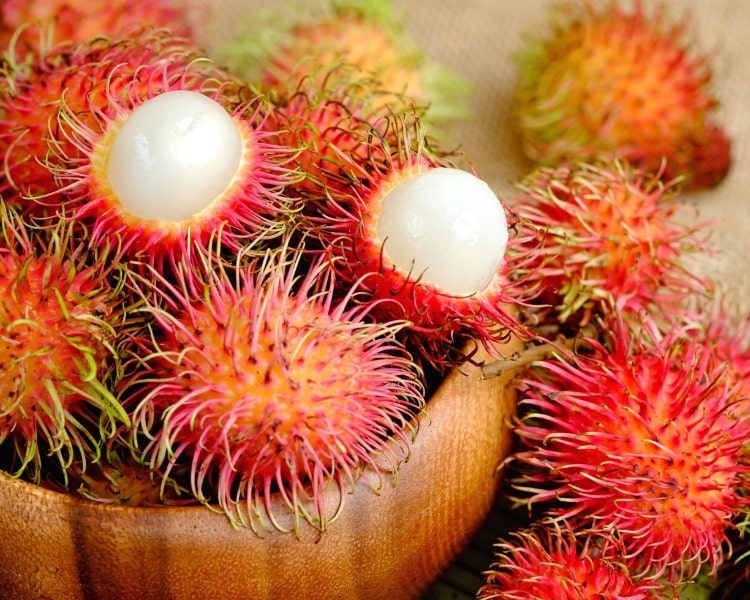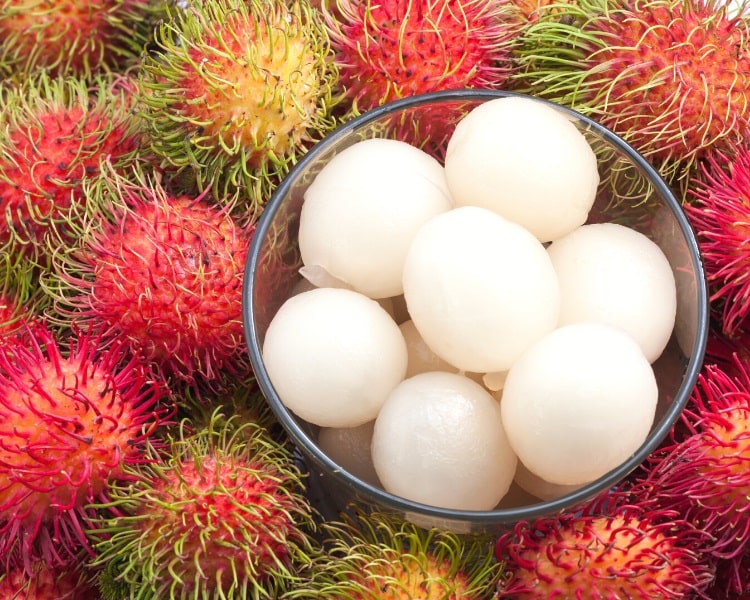Last updated: March 12, 2024
In my never-ending quest to discover as many delicious fruits as possible, it is now time for me to dive a little deeper into the rambutan fruit.
This tiny fruit, with a peculiar outer layer and soft, creamy flesh inside, not only tastes delicious, but it also has an interesting nutritional profile.
Let’s take a closer look at the tropical rambutan fruit, its origins, where to find it, its nutritional benefits, and much more.
What Is a Rambutan?
So, what exactly is a rambutan fruit? If you’re reading this article, chances are you may have never eaten or seen one before. But don’t worry, you’re not alone!
Rambutan is a tropical tree in the Sapindaceae family of flowering plants and trees, also known as soapberry.
This tropical tree is native to Indonesia and other parts of Southeast Asia and produces a small, round fruit, which goes by the same name.

The fruit is very similar to, and is closely related to, lychee and longan fruit.
The flesh inside these fruits specifically has a lot of similarities, with a typical light color, a soft and creamy texture, and a seed in the middle.
Where Does the Name Come From?
The name rambutan is derived from the Malay word rambut, which means “hairy”, and it’s no surprise why the fruit was given this name.
As you can see, the rambutan fruit has a unique appearance, with a mostly red-colored, hairy shell.

Rambutan thrives in tropical climates, and the fruit is now grown in various other parts of the world, such as Africa, Oceania, and Central America.
This has made the fruit perhaps a bit more common and a bit easier to find than other tropical fruits, such as kiwano fruit, durian and dragon fruit.
Eating a Rambutan
While the rambutan fruit may look a bit weird, cutting and eating it is a pretty straightforward process:
- Pick a ripe rambutan, which typically has a red color.
- Gently pierce through the skin in the middle with a knife.
- Peel the skin off from one side of the fruit.
- Use your fingers to squeeze out the flesh.
- Eat the flesh without the seed.
It’s as easy as that. But for a more comprehensive guide including handy recipe tips and ideas, read my article explaining how to eat rambutans.
What Does Rambutan Taste Like?
Rambutan fruit and lychee not only look similar, but they also taste very similar.
The first thing you’ll notice when you eat the flesh of rambutan fruit is its delicious sweet flavor, with a slightly sour aftertaste. The fruit also has a high water content, which makes the flesh juicy but without falling apart.
The sweet taste, combined with the soft texture of the flesh, makes rambutan fruit a real tropical treat!
What About the Seeds?
The seeds in rambutan fruits should not be consumed, as they are known to have toxic elements. In addition to the seed, the skin should also not be eaten.

Interestingly, both the outer skin and seeds of rambutans are actually quite nutrient-rich. But sadly, as mentioned, they are not suitable for consumption.
Where to Buy Rambutans?
This is, of course, very much dependent on where you live, but outside Asia, rambutan fruits (and also lychees) can often be found in specialty grocery stores or otherwise at fruit markets.
Nutritional Profile and Benefits
The table below contains an abstract of the nutritional profile of 100 grams worth of canned rambutan fruit. The reason it’s the canned fruit version is that that was the only one available in the USDA database.

As you can notice, like most fruits, the rambutan is an excellent source of vitamin C, as well as copper, manganese, iron, and specific B vitamins.
Also note that the carbohydrate content is reasonably high (albeit impacted by the fact that it’s canned), which is not surprising considering the sweet taste of rambutan fruit.
| Rambutan Nutritional Profile (Canned syrup pack – 100 g) | |
|---|---|
| Water | 78 g |
| Energy | 82 kcal |
| Protein | 0.65 g |
| Fat | 0.21 g |
| Carbohydrates | 20.9 g |
| >> Dietary fiber | 0.9 g |
| Minerals | |
| Calcium | 22 mg (2% DV) |
| Copper | 0.066 mg (4% DV) |
| Iron | 0.35 mg (3% DV) |
| Magnesium | 7 mg (2% DV) |
| Manganese | 0.343 mg (16% DV) |
| Phosphorus | 9 mg (1% DV) |
| Potassium | 42 mg (1% DV) |
| Sodium | 11 mg (1% DV) |
| Zinc | 0.08 mg (1% DV) |
| Vitamins | |
| Vitamin B1 (Thiamine) | 0.013 mg (1% DV) |
| Vitamin B2 (Riboflavin) | 0.022 mg (2% DV) |
| Vitamin B3 (Niacin) | 1.352 mg (9% DV) |
| Vitamin B6 | 0.02 mg (2% DV) |
| Vitamin B9 (Folate) | 8 µg (2%) |
| Vitamin C | 4.9 mg (6%) |
| Sources: USDA, Wikipedia | |
Benefits
Unsurprisingly, like so many other fruits, the rambutan is, of course, good for you. But it certainly isn’t a nutrition powerhouse that you should start eating right now to improve your diet.
Realistically, it’s just another fruit that is both nutritious and delicious, but it is by no means a fruit that stands out as super healthy.
With that in mind, let’s take a look at some of the nutritional benefits that rambutan fruit can offer us.
1. Source of Vitamin C
Like most fruits, rambutans are a great source of vitamin C, an essential nutrient that supports a number of essential functions in the human body.

Also known as L-ascorbic acid, vitamin C acts as an antioxidant and helps to strengthen our immune system and keep us healthy.
2. Source of Manganese
Manganese is an essential mineral which contributes to several bodily functions, such as the metabolism of amino acids, cholesterol, glucose, and carbohydrates.
Because the human body cannot produce manganese, it is dependent on food intake in order to store manganese in certain parts of the body.
3. Source of Copper
Copper is a trace mineral that is involved in many of the natural processes in the body, such as making red blood cells, maintaining nerve cells, maintaining healthy bones, and supporting the immune system.
As mentioned, the rambutan is essentially just another fruit; its minerals and vitamins can also be found in other fruits and vegetables. In other words, there are no specific nutritional benefits associated with eating rambutan fruit.
Conclusion
Have I managed to get you a little more excited about rambutan fruit? What I like most about this delicious treat is that it makes me feel like I’m on holiday in some far-away tropical resort.
Like so many other exotic fruits, the rambutan fruit, with its sweet flavor and pleasantly soft texture, is an absolute delight.
Here are some more exciting tropical fruits I’ve discovered:

